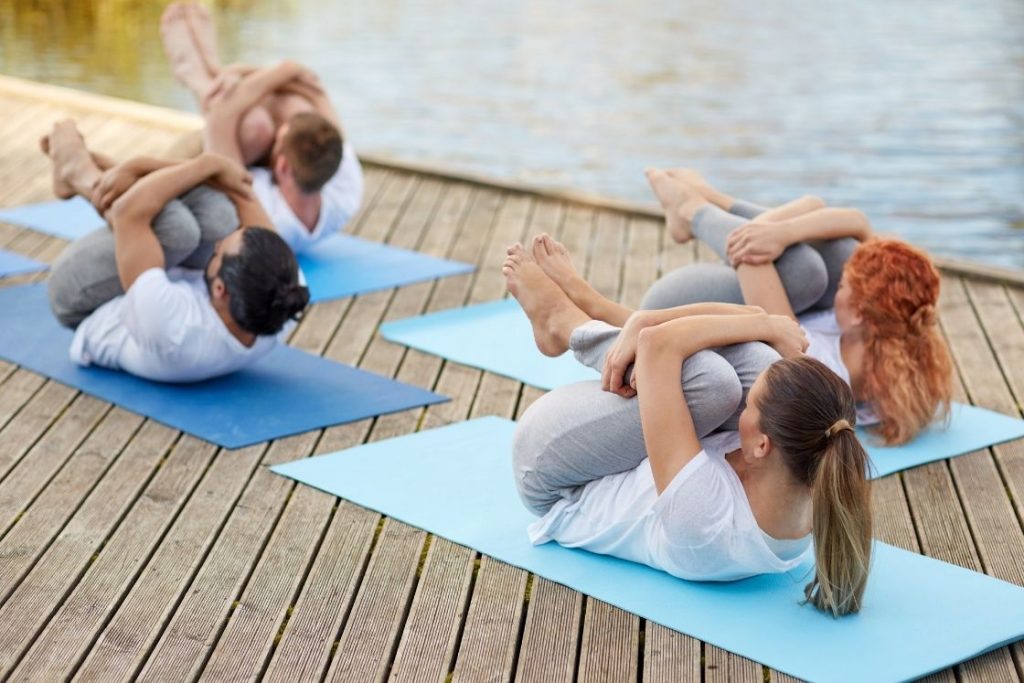
| Sanskrit Pronunciation | Pavanamuktāsana (पवनमुक्तासन) PUH-vuhn-mukt-AAHS-uh-nuh |
| Common | Wind Relieving Pose, Resting Gas Release Pose, Dvi Pada Pavanamuktasana |
| Type | Reclining, Forward Bend |
| Level | Beginner |
| Stretches | Back Muscles, Biceps and Triceps, Hamstrings, Gluteus maximus, Cervical spine |
| Strengthens | Abdominal muscles, Lower back, Hips, Neck, Shoulders |
Pawanmuktasana is a reclining yoga pose suitable for all levels of yogis. While carefully massaging the abdominal organs, its wind-removal characteristics aid digestion and excretion. It helps to relieve stress in the stomach, hips, and low back.
The Sanskrit word Pawanmuktasana comprises three words pawan means wind, mukta means relieving and asana means posture. This pose gets its name from the concept that it aids in the expulsion of gas and can also relieve bloating and stomach pain.
In Pawanmuktasana, you lay down in a supine position then bend both legs and draw them toward the chest with the arms wrapped around the shins. The chin tucks into the chest at the same time. The head can lay on the ground or be raised to the level of the knees.
Practice Guide for Pawanmuktasana
Most practitioners break up this pose into segments by first bringing one knee towards the chest and then bringing both the knees. The raising of the head towards the knee or keeping it on the ground is on the practitioners’ preference and condition of the neck mobility.
It’s a great way to start the day by releasing digestive gases from the stomach and intestines. It’s simple to do and ideal for beginners.
Step by step instructions
Follow the steps below to perform Pawanmuktasana:
- Lie down on your back with your legs extended straight.
- Gently bend the knees and bring them closer to your chest and wrap your arms around the shins.
- Depending on the closeness of the knees to the chest, you can hold your opposite elbows, forearms, or wrists.
- Slowly lift your chest and head off the ground, bend the neck and bring the chin closer to the knees. The forehead should be pointing upward and gaze straight up.
- Maintain this posture while breathing normally.
Hold this pose for 5 to 7 breaths.
Pawanmuktasana looks similar to Apanasana (knees-to-chest pose), however, there is a difference between the two. Pawanmuktasana is a more intense forward bend in which the head is off the ground and neck stretches towards the encircled knees whereas, in Apanasana, the head is kept straight supporting on the ground in the supine position.
Beginner’s Tips
- You can perform pawanmuktasana with one leg at a time to increase the flexibility of your hip and hamstrings.
- Place a folded blanket under your buttocks for extra padding.
- If you have stiff neck muscles, keep them rested on the ground instead of bringing them towards the knees.
- Do not force your legs to fold completely and touch your torso. Go as far as your body allows.
- Placing a small rolled towel or a folded blanket under the neck will give support to the head.
- If you’re unable to hold your shins due to a large belly or chest, bring your knees to the side slightly and use a strap to hold them in position.
- After achieving the final pose, keep actively pressing the belly to the thighs on inhalations.
- To avoid any pressure on the abdomen, place a folded blanket on the tummy to avoid discomfort.
Variations and modifications
Sitting Wind Relieving Pose – If lying down in pawanmuktasana creates discomfort in the breathing or around the neck, an easy approach to begin is to sit and fold the knees and bring them to the chest, balancing the body. The feet should not be placed on the ground and rather be in the air. Even this stance aids in the release of wind/gas.
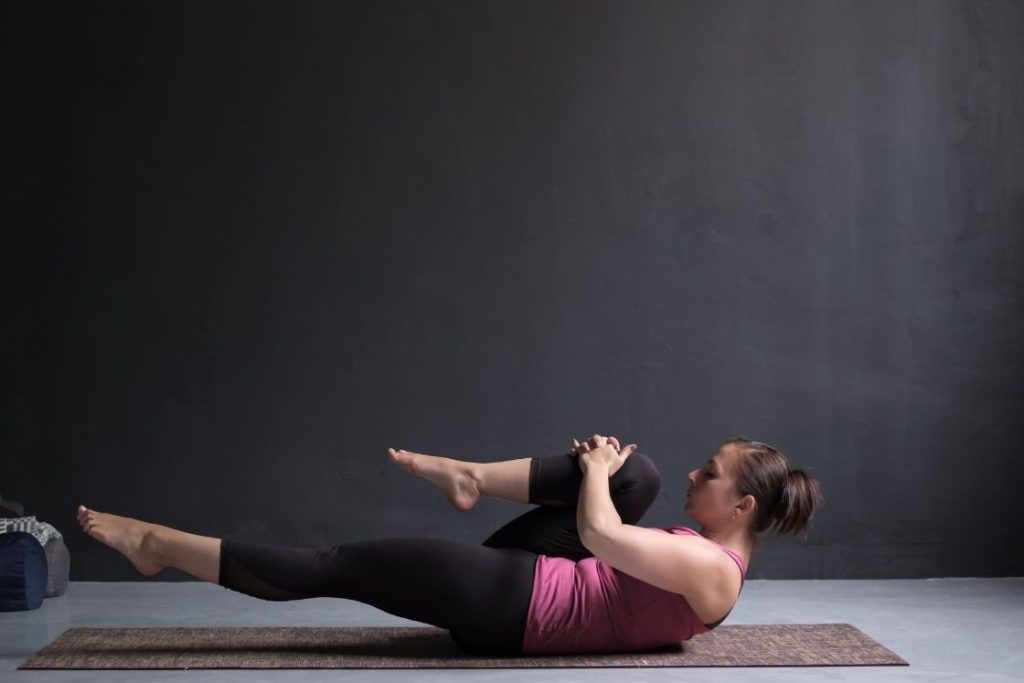
One-legged wind relieving pose – as stated earlier, you can start performing with one leg. You simply need to bend the knee of one leg and bring it towards the chest while keeping the other leg straight. The hand and head alignment stay the same as you would in the traditional wind relieving pose. On the straight leg, you can keep a small bend on the knee if you lack flexibility on the hips, groins, or thighs.
Wind relieving pose on the side – Instead of lying on your back, you can perform the same pose while lying sideways. Here, your legs will be stacked on top of each other along with your hips and shoulders. And you can hold your knees instead of the shins to keep your legs tucked to your chest.
Cow face legs – A modification of the legs can help increase the stretch on the outer thigh muscles and increase mobility of the external hips joints. For this version, bring your legs upwards, perpendicular to the ground. Take your right leg behind the left leg to make an almost X. with your hands on the back of your thighs, bend both the knee while bringing them closer to your chest.
As you bring closer, keep adjusting the leg position so that the right leg is completely outside the left thigh and vice versa. Bend the legs as far as you can and hold your legs at the ankles or shins. This is a somewhat difficult leg alignment and should only be practiced after gaining sufficient flexibility in the hips.
Benefits of Pawanmuktasana
Pawanmuktasana helps in digestion and excretion while also stretching the spine. It strengthens the lower back while toning the arms, legs, and buttocks. This asana is good to release back stiffness and building the core muscles.
Additional benefits are mentioned below:
- Pawanmuktasana helps in cutting the extra belly fat.
- It promotes digestion and relieves stomach problems like constipation, flatulence, acidity, Irritable Bowel Syndrome, etc.
- It Improves blood circulation in the hip joints and relieves lower back strain.
- Pawanmuktasana stimulates the chest muscles and the back of the lungs, improving heart and lung function as well as diaphragm flexibility.
- The combination of lower-body toning and lower-back strengthening, as well as hip stability, improves body posture.
- It can also assist to strengthen the lumbar spine, which can aid with the early phases of lumbar spondylitis, lower back pain, and sciatica.
- It is energizing pose that boosts metabolism and removes toxins from the body.
- Improving hip and lower back flexibility means any accumulated stress in these areas also gets removed.
- Along with the other organs in the belly, the intestines are massaged. which is beneficial to the digestive system
- The flow of blood to the organs that aid in reproduction is ensured by applying pressure on the abdomen, correcting any imbalance in the reproductive system.
- By increasing fresh blood supply to the lower organs, issues such as menstrual cramps, PCOS, infertility, and impotence can also be reduced.
- The spinal toning calms the nervous system which reduces headache, anxiety, stress, etc.
Preparatory Pose
- Bridge Pose (Setu Bandha Sarvangasana)
- Supine Spinal Twist Pose(Supta Matsyendrasana)
- Half Wind Release Pose (Ardha Pawanamuktasana)
- Reclining Bound Angle Pose (Supta Baddha Konasana)
Follow-up Pose
- Half Boat Pose (Ardha Navasana)
- Reverse Pigeon Pose (Sucirandhrasana)
- Revolved Reclined Big Toe Pose (Parivrtta Supta Padangusthasana)
- Fish Pose (Matsyasana)
- Corpse Pose (Savasana)
Precautions and contraindications
Do not perform pawanmuktasana if you’re healing from abdominal surgery, hernia, or piles. Also, if you have a spinal injury or sciatica, you should avoid this pose.
Pawanmuktasana is not recommended for pregnant women and women who have undergone a C-section at the time of delivery as there is a lot of pressure on the abdomen in this pose.
Conclusion
Pavanamuktasana can help to relieve stomach discomfort and low back strain. While you’re still in bed, try a few rounds of this pose initially thing in the morning. You may experience increased ease of movement during your day by gently awakening your body in this manner.
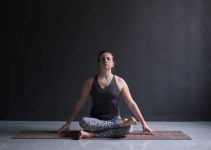
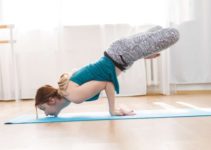
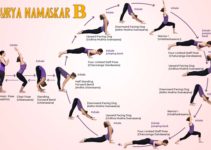


Will pavanmukthasana aggravate Enlarged prostate gland ? Pl guide.